

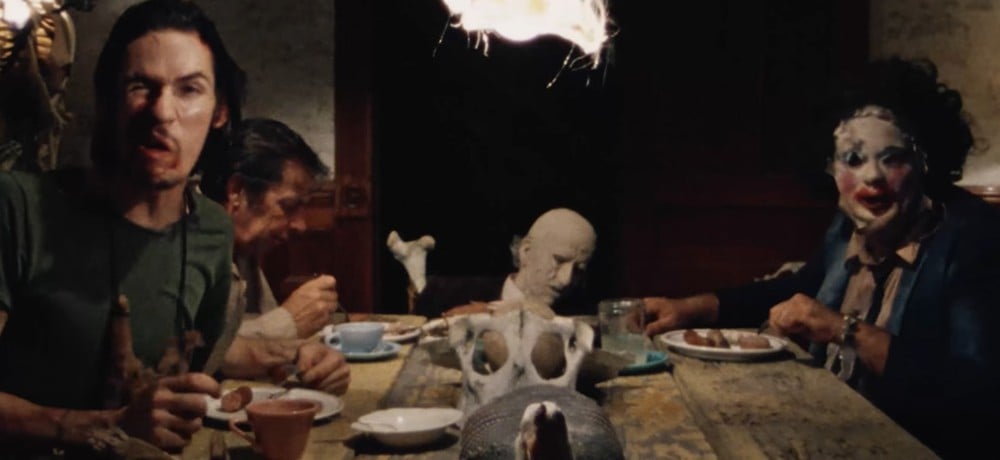
August 18th may seem like just any other August day, but to horror fans it’s a holiday in its own right. Of course I’m talking about “Texas Chain Saw Day.” When audiences see “August 18, 1973,” emblazoned across the screen, they know that an "idyllic summer afternoon became a nightmare." There have been countless articles, books, and think pieces written about this film and franchise, but I wanted to look at its gastro evolution. From the use of dinner scenes to cannibalism (or its omission), the Texas Chainsaw series has its own gastro history worth exploring, so let’s dig in!
I would be remiss if I didn’t start with where this all began, The Texas Chain Saw Massacre (1974). Sally Hardesty being tortured by the family (named The Sawyers, Slaughters, or Hewitts later in the franchise depending on the entry) is easily one of the most intense moments in film history. The scene also has an awful backstory:
“The sequence took a grueling twenty-six hours straight to film, and, although the sequence takes place at night, the sequence was shot during an intensely hot summer day. Blackout curtains were used to cover the windows in order to simulate nightfall, and, while this worked, the curtains also intensified the stifling, still heat within the small dining room. This, combined with the studio lighting that was used, created an intense heat—reaching around 100 degrees—and the (real) animal carcass props and cooked food scattered across the dining table all began to smell. Compounding all this was a concern about continuity—none of the food could be moved from the table, and the actors could not change their clothes, resulting in [Jim] Seidow, Gunnar Hansen, and Edwin Neal all wearing the same clothes for the duration of the shoot.” (Rose, 2013, p. 13)
It was even referred to by some cast and crew members as “the last supper.” (Lanza, 2019, p. 145)
Dinner scenes in horror tend to subvert the idea that sitting down to a family dinner is a calm and relaxing way to end your day. While family dinners were already starting to decline due to the modernization of mealtimes, especially dinner, with frozen entrees, the 1950s still tried to push dinner with the nuclear family unit.
"A Date with Your Family," a '50s instructional film, provides a disturbing peek into the era's rigid rules for dining with Mom and Dad. Mother and daughter switch into nice attire for the meal because, the narrator tells us, "The women of this family seem to feel that they owe it to the men of the family to look relaxed, rested, and attractive." To avoid any distress, one must stick to his or her assigned role, which of course requires a lot of suppression. As the narrator states, "The table is no place for discontent." (Griffin, 2016)
The Texas Chain Saw Massacre flips this completely on its head. While it’s certainly not the first horror film to do this, it is one of the most memorable scenes in film history. You can feel the frenetic energy and anguish that Sally experiences. It oozes tension. The fact that the family tries to convince Grandpa to hit Sally over the head, despite his being physically unable to, showcases their desire to stay with the past rather than move into modernity.
The original film also sets up the cannibalism aspects and rationale that we’ll see come and go throughout the franchise. “The Sawyer family, the cannibalistic antagonists, have been put out of business. Factories and slaughterhouses are moving closer and closer to urban spaces, leaving rural areas even more isolated from the frenetic pace and progress of the metropolis.” (Matthew, 2015) This cannibalism out of necessity comes and goes throughout the series, but I feel it is especially highlighted well in The Texas Chainsaw Massacre: The Beginning (which will be discussed at length later). Worth noting is that as the first film is taking place (and when it was filmed), the United States was going through its own economic turmoil. The period was marred with high inflation (it was literally a period called The Great Inflation), energy crises, and more.
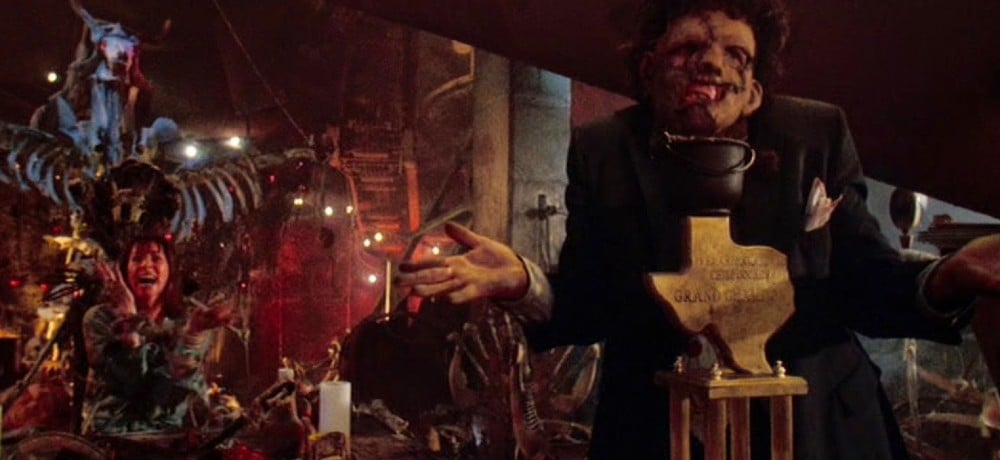
Over a decade later, audiences went back to Texas for The Texas Chainsaw Massacre 2. This entry is campier and far less gritty than its predecessor, which includes how it handled the cannibalism themes. Less than 30 minutes into the film, we find ourselves at the Texas OU Chili Cookoff, where Drayton Sawyer has just won. His secret? “It’s no secret. It’s the meat. Don’t skimp on the meat.” He claims to have “a real good eye for prime meat,” which “runs in the family.”
Likely having seen the original, audiences know what he’s implying, especially when someone finds what he dubs a hard-shelled peppercorn in the chili. It’s in this film that we actually see Leatherface and the family prepare and break down their “prime meat.” A fun fact is that between the time when this film and the original were made, “chili manufacturers and members of the Chili Appreciation Society International successfully lobbied the Texas state legislature to have chili proclaimed the official "state dish" of Texas, "in recognition of the fact that "the only real 'bowl of red' is that prepared by Texans." Chili became the official state dish of Texas when Governor Dolph Briscoe signed House Concurrent Resolution No. 18 (HCR 18) on May 11, 1977. (Knight, n.d.)
Given its ‘80s setting, it’s fitting that we see the Sawyers participating as a way to bring in income. We also learn that Drayton is a caterer in Dallas. Their cannibalism is no longer for self-sustenance but also a means of income for the family. We learn this when Drayton is telling Slim they lost thousands of dollars due to what he thinks is her destroying the house later in the film. Much like the franchise, for better or worse, they are stepping towards modernity and the consumerism of the period.
Speaking of modernization, the third act, where we once again get the dinner scene in The Texas Chainsaw Massacre 2, screams ‘80s while still mostly keeping the theme of the original’s dinner scene. There is arguing during the meal preparation, Leatherface is carving people with an electric knife, and the dinner scene itself is just over the top (complete with a boombox on the table) while reminding us of the shame of the modernization of the Atlas Rendering Company. There is a moment in the build-up to the dinner when Drayton unknowingly sees Leatherface engaging with Slim, where he tells Leatherface to “get that eyeball pate working.” If that isn’t cannibalism for the 80s, I don’t know what is.
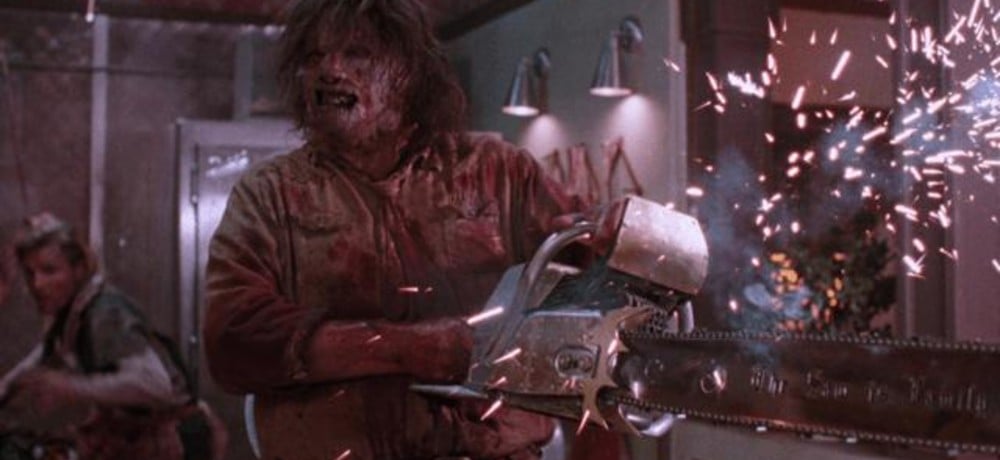
Leatherface: Texas Chainsaw Massacre III brings the family to a more rural setting, closer resembling the first film. This film was made and released in 1990. This was right after Reagan left office, and Reagan’s impact on the United States can be felt in how the family is once again self-reliant.
“During his two terms in the White House (1981–89), Reagan presided over a widening gap between the rich and everyone else, declining wages and living standards for working families, an assault on labor unions as a vehicle to lift Americans into the middle class, a dramatic increase in poverty and homelessness, and the consolidation and deregulation of the financial industry that led to the current mortgage meltdown, foreclosure epidemic, and lingering recession. These trends were not caused by inevitable social and economic forces. They resulted from Reagan’s policy and political choices based on an underlying “you’re on your own” ideology.” (Dreier, 2011)
Even at the time, Reagan’s critics questioned whether his heavy focus on foreign affairs impacted the lack of attention given to the United States.
The dinner scene of the film also reflects the era. Instead of a more “formal” dining room, the kitchen table is in the kitchen itself. The rise of women entering the workforce saw some of its greatest growth in the 90s, which meant meals were quicker and less of an event. We also see Tex (Viggo Mortensen) cooking while Mama Sawyer watches and sets the table. This is the first film in the series (and not the last) where we’ve had a female Sawyer family member, and in line with ‘90s sensibilities, she’s overseeing instead of just cooking. Tex also dons a feminine-looking apron, playing with the “Mr. Mom” stereotype of the era.
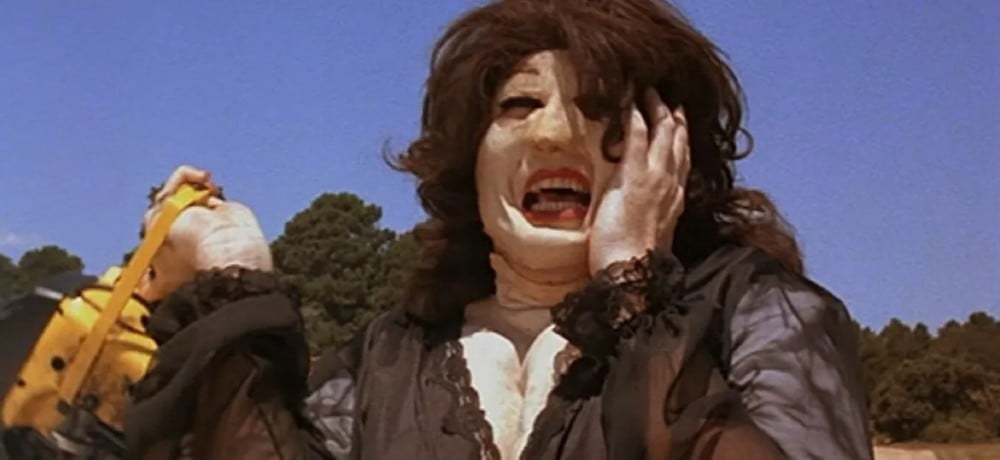
Now we get to my least favorite entry in the franchise, The Return of the Texas Chainsaw Massacre, aka The Texas Chainsaw Massacre: The Next Generation. Not only do I dislike the film itself, but this is also where cannibalism and the dining room scenes made popular by the series start to either disappear or lose their importance. The family, no longer known as the Sawyers but rather the Slaughters, is not motivated by survival or cannibalism. Instead, they torture their victims due to a connection to Rothman, a member of a secret society.
The mid-‘90s brought a rise in right-wing conspiracy theories, so this makes sense. On NPR’s Fresh Air, political columnist and commentator Dana Milbank likened the ‘90s to what we are seeing today with QAnon, saying:
“The rhetoric we heard leading up to the Oklahoma City bombing in 1995 on conservative talk radio from members of Congress talking about the government coming to get them with tyranny, imposing a new world order, a revolution, black helicopters—very, very similar rhetoric.” (Milbank, 2022)
This change in the film means that there is no cannibalism or even an implication of such. In fact, Darla brings home pizza after working, another example of the ‘90s working woman bringing home not only the bacon, but the dinner.
The kitchen and dining room scenes both feel like callbacks to the previous films in location only. Both are full of junk like Vilmer’s batteries, Leatherface’s makeup, etc. They are just set pieces that don’t really serve any storytelling purpose. Without seeing the refrigerator in the background or Darla reheating the pizza, you’d never know they were in the kitchen.
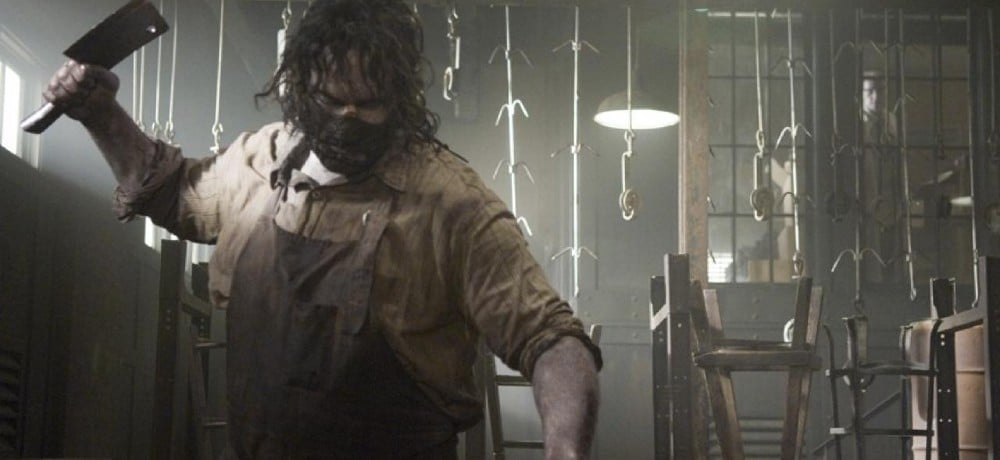
The Texas Chainsaw franchise continued on in the new millennium with varying levels of gastro elements. One of the major differences is that 3 of the films removed the cannibalism element altogether. The Texas Chainsaw Massacre (2003) was written by Scott Kosar and never included any cannibalism or dinner scene.
Director Marcus Nispel was more than okay with this, telling me, “I never cared for that beat, particularly the dinner scene.” He continued on, saying:
“It wasn’t a favorite of mine. There are cannibals, and that seemed sensational and everything, but I don’t think it was necessary. His obsession with fashioning masks out of the faces of his victims, to me, was enough. And this dinner scene where everybody’s just bad, so so bad, and a cannibal, it kind of made him less special. My focus was much more on him and the masks.” (Nispel, 2025)
Leatherface (2017) and Texas Chainsaw Massacre (2022) both also have their cannibalism elements gutted, literally.
The Texas Chainsaw Massacre: The Beginning gives us the only major reprieve from this sacrilegious lack of cannibalism. It actually sets up the reasoning for it as survival after the slaughterhouse has been shut down, which harkens back to the original. What’s also interesting and unique to this film is that there is some trepidation amongst the family members. However, they eventually give in and get eating. I asked director Jonathan Liebesman why he thought that cannibalism was brought back in after The Texas Chainsaw Massacre (2003) omitted it, and he said:
“It was a scene that really shocked me from Tobe Hooper's film. The cannibalism didn’t feel like gore for gore's sake—it was a really effective way to dramatize this family's complete disconnection from civilization.” (Liebesman, 2025)

Texas Chainsaw, aka Texas Chainsaw 3D, has some very lightly implied Sawyer cannibalism, but it is never overtly shown in the film. According to Adam Marcus, who wrote the original screenplay with his wife Debra Sullivan, there was a specific reason for the missing component. They were brought in to replace Steve Susco, whose script was chock full of cannibalism and gastro elements. They weren’t even allowed to look at it lest they be inspired to add any similar elements. They told them flat out, “There would be absolutely no cannibalism.” This was largely because Midnight Meat Train was a disaster for them. Therefore, cannibalism was "off the table." (Marcus, 2025)
The other gastro element seemingly missing from most of these films is a 3rd act dinner scene. I think there are a couple of reasons for this. First and foremost, by the early 2000s, the family dinner wasn't what it once was. Gen X and Millennials rely more on quick and convenient meals than past generations.
“The need for convenient dinnertime options has far less to do with millennials’ cooking skills and more to do with their lifestyles and changing households. There are more single-person households and a record number of multigenerational households than ever before. Couple that with the surge of millennials entering the gig economy and the decline of the 9 to 5 workday and you’ve got a roulette of dinner situations.” (Vox Creative, 2019).
In Texas Chainsaw 3D, we see Leatherface dining primarily by himself. According to Adam Marcus, this was out of necessity because he was hiding from law enforcement. (Marcus, 2025) Even without intention, it’s sadly reflective of the time as well as Baby Boomers coming to terms with losing their family due to age. He no longer has a family to eat with even if he wanted to. Leatherface (2017) has a dessert scene in the beginning and a meal scene set in a diner, but neither really uses the meal itself to further the plot.
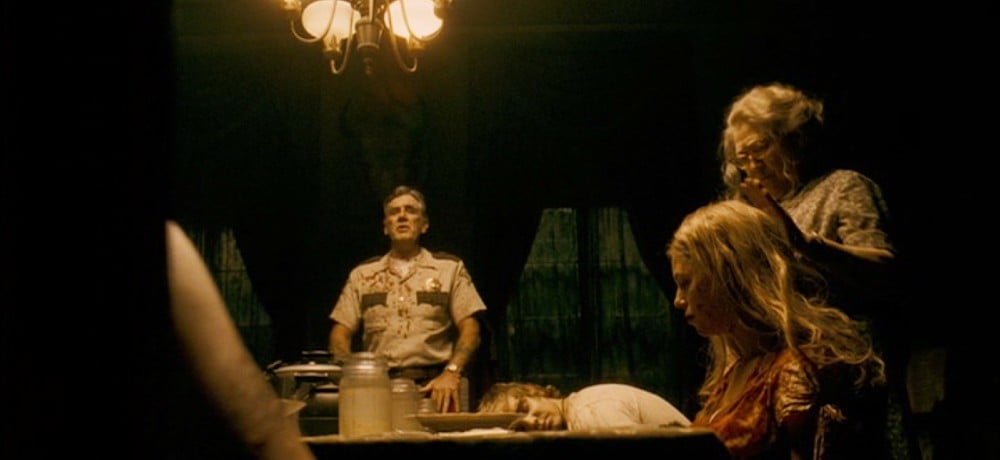
The exception to the removal of the dining scenes is The Texas Chainsaw Massacre: The Beginning. It has not only one dinner scene but two! The first being when the family converts to cannibalism out of necessity and Hoyt gives a speech about how they won’t abandon their place of birth, and they are on their own. On why he thought the dinner scene was so important to the franchise and why it was brought back, Jonathan Liebesman said:
“The idea of banal dinner time, but eating people, is so indelible from the original. The juxtaposition of a normal family ritual with the horror of cannibalism traumatized me! It's one of those images from Hooper's film that burned into my memory—the twisted family gathering around the table, maintaining these everyday social gatherings while committing the ultimate sin.” He also mentioned, “Cannibalism at family dinner is primal and disturbing—this family created their own horrific ecosystem.” (Liebesman, 2025)
An element that these films added that wasn’t used in the first four is the slaughterhouse as a set piece. In the previous entries, the slaughterhouse closing served as backstory only. These films place characters there either during exposition or a chase scene. While not necessarily the intent, it could be read that the emphasis on the slaughter could be a reaction to US soldiers being sent overseas in a post-9/11 United States.
What I find fascinating is that between Marcus Nispel, Jonathan Liebesman, and Adam Marcus, there was no real consensus to this. Marcus stated:
“It was a great setting to open things up at the end of the movie. The last act deserves a special setting. It also allowed for more interesting staging, the switcheroo with the pig and locker, that sort of thing. She’s going to get slaughtered, but not for human consumption. We left the door open for interpretation.” (Nispel, 2025)
Jonathan discussed how the slaughterhouse was a grounding element, saying:
“There was an authenticity to slaughterhouses and that locale that helped ground the story and location. The slaughterhouse gave me context for the family's brutality—it shows how killing became routine for them, like any other job. For some reason it also reminded me of forgotten communities and a real American landscape.” (Liebesman, 2025)
Among other things, Adam pointed out that the rise of vegetarianism and veganism in the ‘90s and onward made the slaughterhouse a far scarier setting than when people were more closely connected to how they got their food in the ‘70s:
“The idea of a slaughterhouse has become more and more repugnant to people, even though most people eat meat. There is something about seeing the way it’s processed, seeing the slabs hanging.” (Marcus, 2025)
Much like the removal of the cannibalism and dining scenes, Leatherface (2017) and Texas Chainsaw Massacre (2022) don’t utilize the slaughterhouse, though both have scenes set on pig farms.

Speaking of Texas Chainsaw Massacre (2022), there are a few interesting things happening in terms of food. First, when the group comes to Harlow, there is a lot of discussion about food trucks, opening restaurants, etc. Basically, food is not family time but rather a means of gentrification and making money. We only see one meal, and that’s the barbeque being offered to the investors/bidders. They eat and drink to be seen or network, not to enjoy the company of each other.
In fact, the only genuine hospitality comes from Alice Krige’s character, who offers Melody and Dante iced tea. They proceed to falsely tell her that she doesn’t own her property, causing her to have a heart attack. Not a great way to treat someone who is welcoming you.
The second is the scene mentioned earlier when discussing the setting of a pig farm. Here we see a retired Sally slaughtering and breaking down pigs. In The Texas Chain Saw Massacre, when the hitchhiker was talking about animal slaughter, she seemed to be turned off by the topic. However, after her experiences with the Sawyers and as a Texas Ranger hunting for Leatherface, that has changed; she’s changed. Using this act to show that is subtle but effective.
Food and meals are something that connect all of us. The use of food as a cultural lens has always been intriguing to me, and getting to revisit my favorite franchise with it has been an adventure. I hope you learned as much as I have and find even more to appreciate about this iconic and important franchise. Happy Texas Chain Saw Day!
---
Dreier, P. (2011, February 4). Reagan’s Real Legacy. Retrieved August 10, 2025, from The Nation.: https://www.thenation.com/article/archive/reagans-real-legacy/#:~:text=In%20his%20first%20year%20in,honor%20of%20our%20fortieth%20president
Griffin, M. (2016, February 16). 'No Place For Discontent': A History Of The Family Dinner In America. Retrieved August 9, 2025, from NPR: https://www.npr.org/sections/thesalt/2016/02/16/459693979/no-place-for-discontent-a-history-of-the-family-dinner-in-america
Knight, R. (n.d.). The Unofficial History of Texas Chili. Retrieved August 9, 2025, from Chili Cats: https://www.chilicats.com/chili-history#:~:text=The%20first%20recorded%20chili%20contest,named%20chairman%20of%20the%20contest
Lanza, J. (2019). The Texas Chain Saw Massacre: The Film that Terrified a Rattled Nation. New York, NY, United States: Skyhorse Publishing.
Liebesman, J. (2025, August 15). (S. Stubbs, Interviewer)
Marcus, A. (2025, August 14). (S. Stubbs, Interviewer)
Matthew. (2015, October 14). The economics of The Texas Chain Saw Massacre 1 and 2. Retrieved August 9, 2025, from Medium: https://medium.com/@mmmontycarlo/the-economics-of-the-texas-chain-saw-massacre-1-and-2-91f381073e74
Milbank, D. (2022, August 9). How the Republican Party came to embrace conspiracy theories and denialism. Fresh Air. (T. Gross, Interviewer) NPR. Retrieved August 14, 2025, from https://www.npr.org/2022/08/09/1116281152/how-the-republican-party-came-to-embrace-conspiracy-theories-and-denialism
Nispel, M. (2025, July 29). (S. Stubbs, Interviewer)
Rose, J. (2013). Devil's Advocates: The Texas Chain Saw Massacre. Leighton Buzzard, Bedfordshire, United Kingdom: Auteur.
Vox Creative. (2019, March 28). The Evolution of Dinnertime. Retrieved August 15, 2025, from Eater: https://www.eater.com/ad/18285548/evolution-family-dinner-history